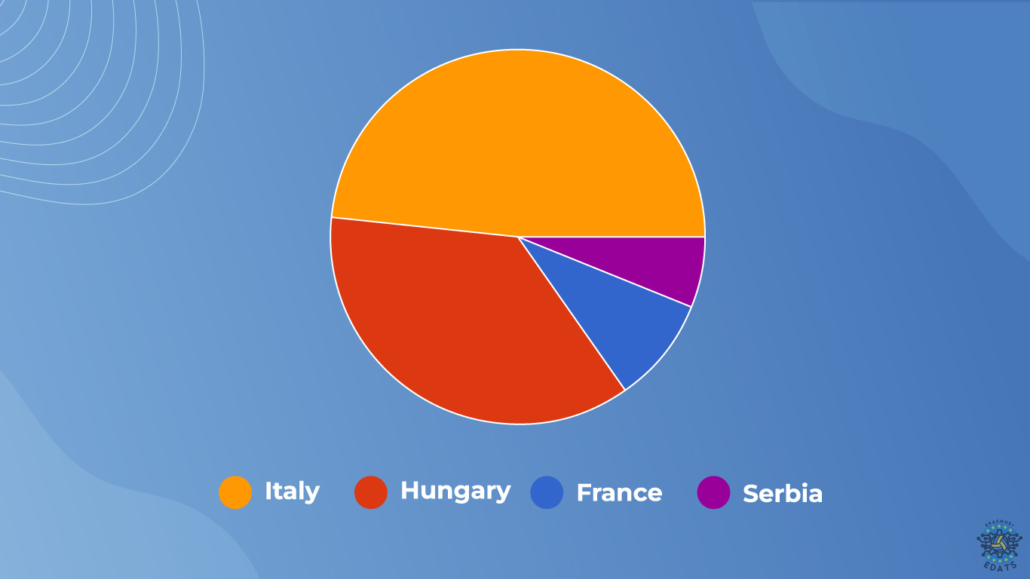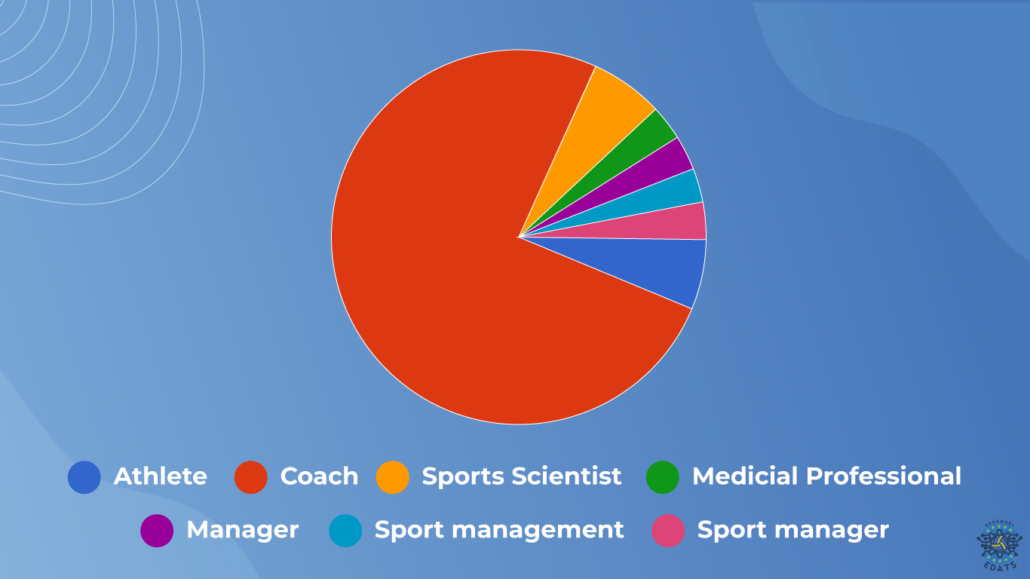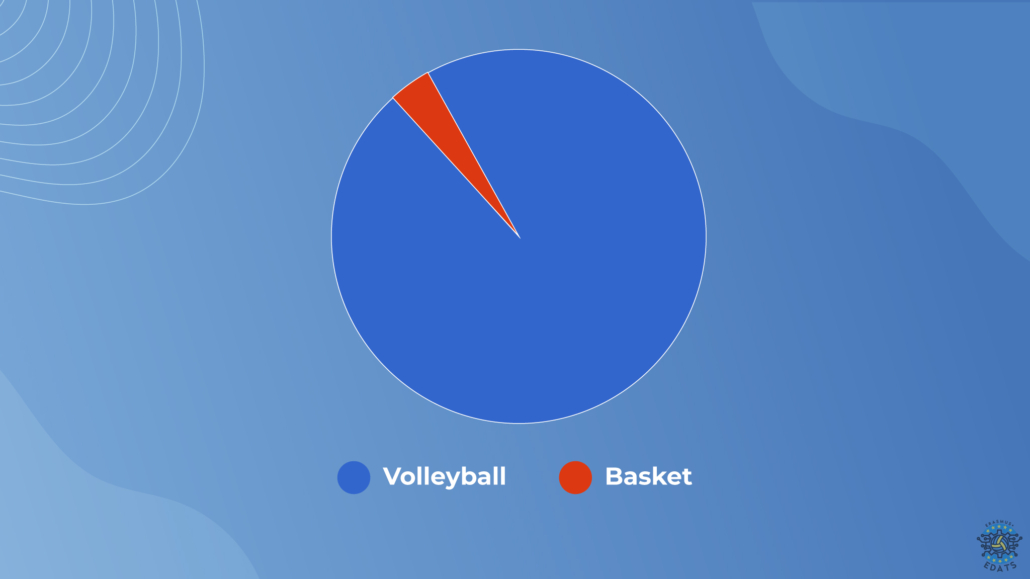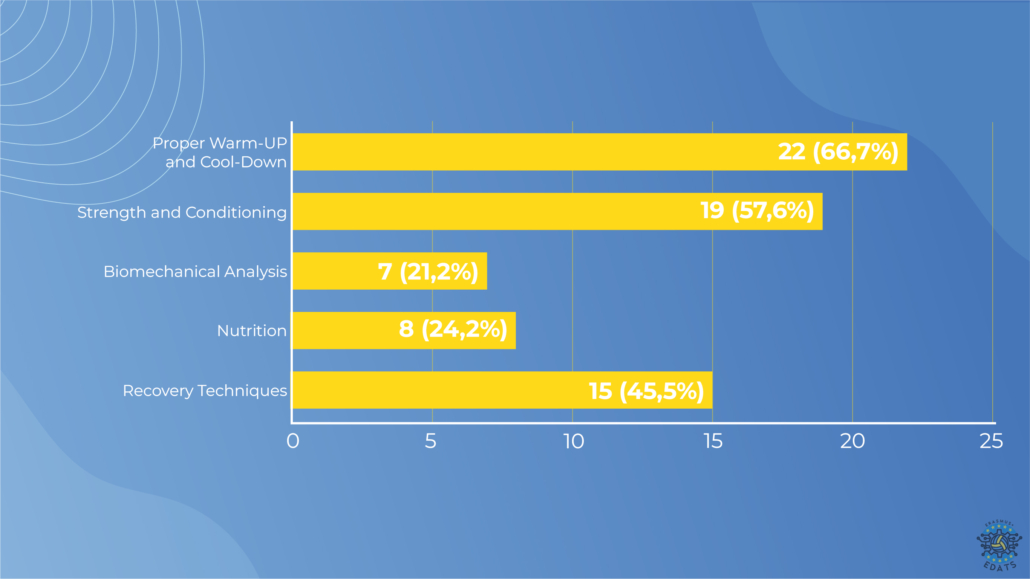Biomechanical Data and Sensor Use in Sports
The primary objective of this initiative is to identify best practices in biomechanical data collection for sports beyond volleyball. Data gathered from the questionnaire highlights a variety of current experiences with biomechanical systems and identifies challenges, particularly around the selection and effective use of sensors.
Participants Profile
As shown by Figure 1 and 2, most respondents (predominantly coaches) come from the countries which compose the consortium, namely: Italy, Hungary, France, Poland and Serbia, thus providing a true European perspective on sports training and data collection needs. The analysis of age range data, which indicates an average around 40, suggests a mix of experience levels, likely providing insights from both established and emerging practices in the field. As shown by Figure 3, the varied background helps ensure that the findings reflect diverse viewpoints, especially those of coaching professionals who are pivotal in implementing training methodologies and data practices.
Figure 1: Nationality of respondents
Figure 2: Professional profile of respondents
Figure 3: Sport background of respondents
Experience with Biomechanical Data Collection Systems
Responses indicate that nearly half of the participants (45%) currently use biomechanical data collection systems in their training or professional practice. This suggests moderate adoption, with a notable portion of respondents (55%) either not using these systems or lacking familiarity with them. The relevant percentage of the latter is probably due to the cost of the systems (often considered not affordable especially for small clubs), resource requirements, and expertise needed to effectively integrate the results obtained from the biomechanical systems into the daily training planning routine, especially for sports practitioners who might prioritize practical training methods over technology-driven analytics.
Sensor Types and Preferences
Among those using biomechanical systems, accelerometers and force plates are the most employed devices, due to their versatility in measuring kinematic (i.e. accelerations, speed and trajectories) and kinetic (i.e., forces) parameters. Such preferences highlight a focus on tracking biomechanical parameters that are universally applicable across many sports. However, a few responses mention the use of in-body sensors and motion capture systems, signaling an interest in more advanced or specialized data. This variety in sensor choice may reflect both the financial and logistical considerations of adopting complex tools in different sports contexts.
Perceived Effectiveness of Data Extracted by Biomechanical Systems
Most participants find biomechanical data collection systems effective in terms of contribution to improve their training programs, with a significant number of respondents labeling them “effective” (50%) or “very effective” (20%). Only a few report a neutral stance, suggesting that while users generally see value in these tools, some may struggle to fully leverage their potential. The enthusiasm for these systems likely stems from their ability to provide precise feedback, though there appears to be room for improvement in training on system use and data interpretation.
Key Challenges in System Utilization
The main challenges revolve around ease of use, cost, system integration, and data interpretation. For many respondents, the cost remains a prohibitive factor, particularly in sports environments where budget constraints are common. The complexity and integration with other training systems also pose issues, making it difficult for users to combine data from multiple sources or apply it in real time. This highlights the need for further “low-cost” affordable, user-friendly technologies and emphasizes the importance of developing best practices for data integration and interpretation, potentially through standardized protocols and training resources.
Injury Prevention Priorities
As shown in Figure 4, a substantial portion of respondents emphasize the importance of proper warm-up and cool-down routines and strength conditioning as pillars of injury prevention. Recovery techniques are also frequently highlighted, indicating a broad recognition of the value of holistic approaches to athlete care. This reflects a preventive approach to sports training that combines physical preparation, recovery strategies, and biomechanical assessments, aligning with modern understandings of injury mitigation.
Figure 4: Replies on the most critical aspects of injury prevention in sport training
Digital Technologies in Training
The application of digital technologies in training is quite widespread, with video analysis tools and training apps as the most widely employed. These tools offer valuable visual feedback and structured progress tracking, enhancing athletes’ and coaches’ abilities to monitor and refine performance. Wearable devices, although not as prevalent, provide more individualized data, often used alongside other digital platforms. This enthusiasm for digital tools reflects a growing appreciation for data-driven coaching, even in smaller or less funded training environments.
Environmental Sustainability Perspectives
Three-quarters of respondents consider sustainability either important or very important, indicating a growing awareness of environmental impact within sports contexts. Suggestions for improvement, like using energy-efficient facilities and sustainable equipment, illustrate a movement toward integrating eco-friendly practices within sports organizations. This priority aligns with broader societal trends and points toward an emerging responsibility for sports professionals to consider their environmental footprint.
Conclusion
This project findings provide a solid foundation for enhancing collaboration between sports professionals and technology experts, advancing biomechanical data collection practices, and creating an ICT platform to support athlete well- being and performance. The insights gathered through the questionnaire highlight key areas of alignment and opportunity to address the project’s goals.
Strengthening Collaboration Across Disciplines
The responses reveal a gap in shared knowledge and access to biomechanics-focused resources among sports professionals. Although many coaches and athletes recognize the benefits of biomechanical data, challenges regarding cost, complexity, and data interpretation indicate a need for interdisciplinary collaboration. By connecting sports professionals with technology experts, it would be possible to create a knowledge-sharing network that demystifies biomechanical data, aligns technology choices with practical training needs, and facilitates real-world applications.
Collaborative workshops, training modules, and shared resources will empower coaches, trainers, and sports scientists to effectively apply biomechanical insights, enhancing the coach-athlete relationship through improved understanding of individual needs and performance indicators.
Selecting Sensors and Defining a Data Collection Methodology
The survey shows a preference for widely accessible sensors, such as accelerometers, force plates, and motion capture systems, particularly for measuring movement, force, and speed. These tools are commonly associated with injury prevention and training optimization, aligning well with project goals.
Based on the user feedback, a clear methodology can be developed that focuses on standardized data collection practices for injury prevention and performance improvement. This methodology should outline:
- Sensor selection guidelines based on sport-specific needs, cost- effectiveness, and ease of use;
- Data collection protocols that prioritize ease of interpretation, enabling coaches and athletes to make quick, evidence-based adjustments in training;
- Integration steps to combine biomechanical data with digital training tools like video analysis and wearables, fostering a seamless, data- informed approach to coaching.
This systematic approach can serve as a benchmark for data collection, ensuring consistency, reliability, and broader applicability across sports environments.







